The MGA With An Attitude
COOLANT BYPASS for the Twin Cam - TC-324A
The article on prior page has information on the MGA Twin Cam thermostat assembly and how it works, as well as the remote reservoir, pressure relief cap, and the later remote pressure relief valve. The thermostat will stop or restrict coolant flow during warm-up period to promote quick warm up to normal operating temperature. It is definitely not good for the engine to run cold, as slow vaporizing unburned fuel can wash oil off of cylinder walls to promote more rapid wear of the cylinder walls and piston rings, as well as diluting lubricating oil in the sump. After warm up, the thermostat will open and regulate flow of coolant to maintain the desired minimum operating temperature. All coolant that goes through the thermostat outlet will go through the radiator before returning to the water pump to recirculate through the engine.
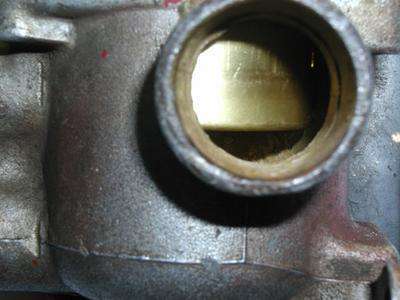
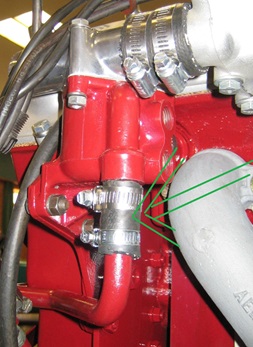 As temperature increases the thermostat will open wider to allow more coolant flow. Once the thermostat is wide open it has no more effect on running temperature. Beyond this, maximum operating temperature is limited by the radiator dissipating heat as fast as the engine can generate more heat (equilibrium in heat flow).
As temperature increases the thermostat will open wider to allow more coolant flow. Once the thermostat is wide open it has no more effect on running temperature. Beyond this, maximum operating temperature is limited by the radiator dissipating heat as fast as the engine can generate more heat (equilibrium in heat flow).
Beside and just below the thermostat there is a bypass port that can allow some coolant to bypass the thermostat and return directly to the water pump to re-circulate through the engine without going through the radiator. This promotes quicker warm up while allowing some coolant to flow through the engine while the thermostat is still closed, avoiding hot spots in the cylinder head.
The original style thermostat has a ring or sleeve around the outside. As the thermostat warms up and opens, the sleeve moves down to cover and close the bypass port. With the bypass closed, all coolant flow will go through the radiator, and none will be allowed to bypass.
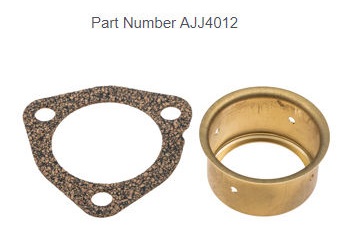 There is an optional blanking sleeve that can be installed in place of the thermostat. This sleeve will permanently block off the bypass port, and will always allow full flow of coolant through the radiator. The blanking sleeve is useful for competition where warm up time is not so much concern, but maximum coolant flow is desired for hard running operation. The blanking sleeve is not recommended for a street car to be used in cool weather when a thermostat is definitely needed to maintain minimum operating temperature. Proper warm running temperature is also good to enable the (optional) heater and demister to work in cool weather.
There is an optional blanking sleeve that can be installed in place of the thermostat. This sleeve will permanently block off the bypass port, and will always allow full flow of coolant through the radiator. The blanking sleeve is useful for competition where warm up time is not so much concern, but maximum coolant flow is desired for hard running operation. The blanking sleeve is not recommended for a street car to be used in cool weather when a thermostat is definitely needed to maintain minimum operating temperature. Proper warm running temperature is also good to enable the (optional) heater and demister to work in cool weather.
Original style moving sleeve thermostats have become rather rare, hard to find, and expensive when you can find one, but there are some alternatives. You can install a blanking sleeve along with a modern sleeveless
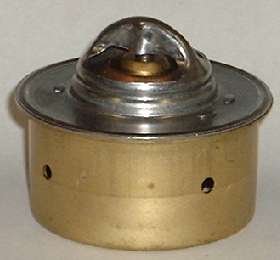
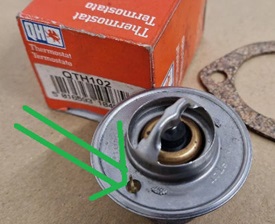 type thermostat. The new thermostat will need a small hole drilled in the flange to bleed out air while filling coolant, and to allow a small amount of fluid bypass to avoid hot spots in the cylinder head during warm up. Keep that drill hole small to maintain the intended quick warm-up function of the thermostat.
type thermostat. The new thermostat will need a small hole drilled in the flange to bleed out air while filling coolant, and to allow a small amount of fluid bypass to avoid hot spots in the cylinder head during warm up. Keep that drill hole small to maintain the intended quick warm-up function of the thermostat.
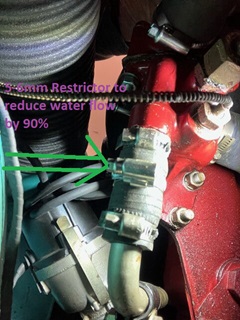
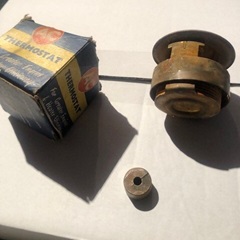
Without a blanking sleeve, you can install a restrictor orifice in the bypass port. This will allow a limited small flow to bypass during warn up, but will stop most of the bypass flow during normal warm operation. The original Twin Cam bypass port connecting hose is 5/8-inch bore size. installing a 5-mm restrictor orifice (3/16-in) will reduce cross sectional flow area by 90%. This may be reasonable for those who may be averse to completely blocking the bypass port.
|